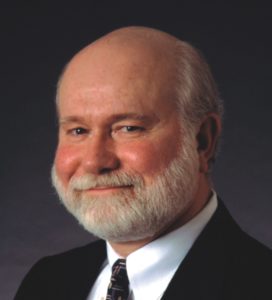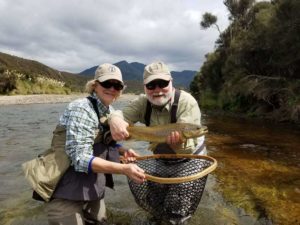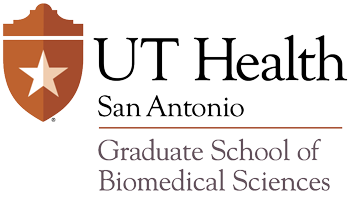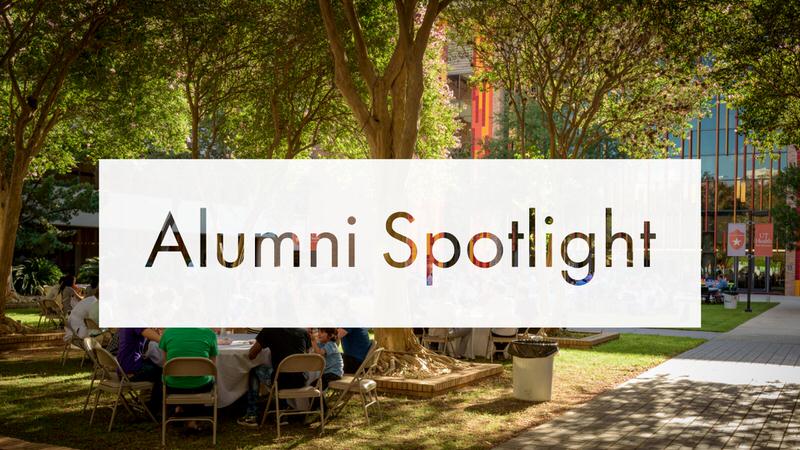Alumni Spotlight: Rodney L. Sparks, J.D., Ph.D.
 1) When did you first become interested in science?
1) When did you first become interested in science?
I don’t remember exactly, but it was as a child. I asked for a microscope kit in about third grade and got it for Christmas and used it in several science fairs during elementary school.
2) Why did you pick The University of Texas Health Science Center at San Antonio and your program?
In college I became interested in control of cell growth and differentiation and one of my professors introduced me to Dr. Ivan Cameron (now retired) who was studying cell cycle and cancer. After applying and then visiting/interviewing I accepted an offer and started in his lab immediately after I graduated from college.
3) Tell me more about your career path.
I started as a scientist, but am on a second related career. I did a postdoctoral fellowship at Johns Hopkins with Dr. Paul Ts’o, probably the best funded faculty member there at the time, and did work on carcinogenesis and stem cells. From there I did a second fellowship with Dr. Robert Scott at the Mayo Clinic because he had developed two good stem cell models for studying cell growth, differentiation, and the uncoupling of those two processes in cancer. I then took a faculty position at the Oregon Health Sciences University and after several years there was recruited to Tulane Medical School and later received tenure. As a faculty member I continued working on the coupling of cell proliferation and differentiation defects that lead to cancer. I was funded by the National Cancer Institute and other agencies and foundations.
While in Oregon I was exposed to several biotechnology companies and started to become familiar with patenting and the biotechnology industry. While at Tulane I started doing some consulting in biotechnology and I became interested in patent law. I had several friends (Ph.Ds.) who had become patent lawyers and decided to use my background to do the same because of the boom in biotechnology patent law and the need for patent lawyers with cell and molecular biology expertise. I went to law school at night and when I graduated I was able to help everyone in my lab move on and had my R01 NIH grant transferred to another faculty member. I was recruited by a large law firm in Philadelphia and that is where I began my law firm patent attorney career and where I trained in patent law. Most of my clients were university technology transfer offices so I was not really too far from academic research. In fact, because of my time as a scientist I knew at least one faculty member personally at almost every university that was a client.
After having been in private practice in Philadelphia for a few years, a headhunter working for the University of Virginia contacted me about a biotechnology patent position with their technology transfer group. UVA is one of the few universities with in-house patent counsel. I interviewed, accepted an offer, and have been here for 13 years.
4) Tell me about your current career, what do you do?
I am senior biotechnology patent counsel for the University of Virginia Licensing & Ventures Group and oversee the biotechnology and pharmaceutical/chemical technology patent portfolios for the university and provide guidance and opinions on issues related to patenting, technology ownership and licensing, and patent litigation. I have an active portfolio of my own where I write and prosecute patent applications, but most of our patent work is done by outside patent counsel because of the size of our portfolio.
5) What is a day like in your job?
I do a variety of things so every day is not the same. About 60 percent of my time is directly related to patents and patent applications. I meet with faculty, postocs, and graduate students to discuss their new inventions or to discuss an active patent application that is in prosecution. I also meet with companies that have licensed our technologies or are interested in licensing one of our technologies. Of course, I also write patent applications, prepare responses to office actions issued by the U.S. Patent and Trademark Office or by foreign patent offices, and occasionally interview Examiners to try and get a patent allowed. I give talks to various faculty groups, graduate programs or classes, and even administrators. The talks range from an overview of patenting in general or for the scientists more specifically on the requirements for obtaining a biotechnology or pharmaceutical patent. On occasion I have to write legal opinions for the university on patent topics such as ownership and co-ownership of technology, inventorship, and patentability of an invention.
I am active in several professional societies, have published several articles and even a book chapter on various aspects of patenting and licensing technology, and have been quoted in Nature twice in the last couple of years on high profile biotechnology patent issues (CRISPR and antibodies). We have been involved with several patent litigations where I have provided litigation support and I have been either lead or backup counsel on eight Inter Partes Reviews initiated against us at the U.S. Patent and Trademark Office to try and invalidate some of our patents. I have an adjunct faculty position at the University of Virginia School of Law and teach a patent law clinic on how to prepare a patent application and an advanced course on current topics in patent law and licensing.
6) How did the education you get at The University of Texas Health Science Center at San Antonio prepare you?
I learned discipline and focus, critical thinking, and received a solid education in the pertinent sciences (cell biology, biochemistry, physiology, immunology, and even the anatomical sciences). Because I was in a very active lab that published a lot, I became a much better writer and editor and became a better public speaker.
7) What is the most challenging part of your work?
Patent law is filled with deadlines, many of which are “fatal” to a patent application or patent if not met. Trying to meet those deadlines when others can’t make a decision can be stressful.
8) What is the most rewarding part of your work?
It always feels good when we get a patent (it can take several years from the time an application is filed) or when one of our technologies is licensed. On occasion, one of the licenses will result in a substantial sum of money for the inventors and that makes them quite happy.
9) What has been your proudest achievement?
I have helped guide several inventors and startup companies over the years through the patenting process and successful commercialization of their inventions, although the road to success is usually a bit bumpy.
10) What would you tell a current student interested in your career?Any advice?
Most high level patent law work in biotechnology or chemistry/pharmaceuticals is done by Ph.D. patent agents (no law school required) or lawyers with Ph.Ds. Just like science, if you choose that path go to the best law school you can and do well. It will make it much easier to get a job at a good law firm. There is a need for patent attorneys with good science backgrounds, but I don’t think that the market is quite as strong as it was back in the 1990s when I got involved. Having a Ph.D. satisfies the requirements needed for taking the patent bar examination and becoming a patent agent. Many law firms use patent agents because they can bill at a lower rate than someone who is a patent lawyer. Being a patent agent can be a good job as well.
 11) What do you like to do outside of work?
11) What do you like to do outside of work?
I have always been into cars and still attend or participate in car shows. My wife and I like to travel and I have been to all but about four of the states and we have been to several foreign countries. I started fishing with my father when I was very small and try to go as often as I can and have fished in quite a few states. Our son is not as big a fisherman as I am, but we have taken fishing trips to Alaska, Yellowstone, and to the Columbia River where we caught sturgeon over eight feet long. I started fly fishing after moving to Virginia and have done quite a bit of fly fishing since moving here. The extra picture I have included is from a trip to New Zealand earlier this year with my wife Marcia. We got to fish several days while there and the picture show us with a brown trout I caught on a fly.

